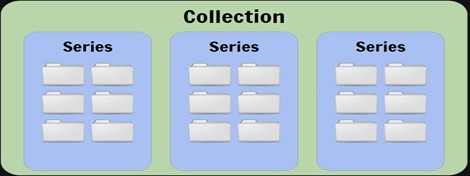Archival Preservation 101: Preservation Through Simple Archival Processing
Preservation Through Simple Archival Processing
Heidi Marshall, Head of Archives & Special Collections, Columbia College Chicago
Speaking broadly, archives and special collections preserve and maintain unpublished or rare primary materials produced during the lifetime of a person or organization, retained for research or evidential value. Libraries maintain published secondary materials produced well after this period, holding content that has been synthesized or interpreted by its authors.
While archives and libraries do share functions, such as acquiring, processing, and cataloging materials, this is where similarities cease. Libraries process each book and note each magazine issue in its catalog record, whereas archival collections simple cataloging takes place at the collection level, then folder level, rather than individually cataloging each piece of paper or digital file in a collection. Generally, the only time archival repositories catalog at the item level is if an item is to be published online.
Archival collection level processing follows the guiding principles of provenance and original order to preserve collection contents. Arrangement in archival processing is performed through a method called appraisal, a form of document analysis, that helps determine whether records or other materials have permanent archival value. The latter term refers to whether items are kept based on their ability to illustrate history, activities, creative processes, or evidence something took place, which is different from monetary appraisal that estimates fair market value. Level of arrangement is generally determined by the archival repository.
The goal of arrangement is to gain both physical and intellectual control over the collection. Physical control refers to the act of arranging a collection, such as foldering, boxing, and grouping together certain materials within a collection. Physical control translates to digital materials, too, and a similar process occurs. Intellectual control involves conceptualizing how certain materials must be grouped together. Such groupings are referred to as series, which can mimic a filing system through grouping material based on function, content, or format. Important considerations in an arrangement scheme are the collection's original order and the ease of intellectual access to information in the collection.

Image courtesy of Archives & Special Collections, Columbia College Chicago. Diagram of a collection level simple hierarchy for processing archival material.
If the collection’s original order has been preserved, it is easier to process. However, if the original order has been destroyed or cannot be figured out, it is the archivist’s responsibility to apply logical order. There are several ways to consider processing unorganized material – chronological, alphabetical, subjects, or formats. Such groupings on the part of archivists are based on best practices and standards. Sample archival processing manuals are online at the Society of American Archivist website.
Arrangement allows for preservation checks of both physical and digital content. Physical content benefits from removal of paper clips, rubber bands, and fasteners and the possibility of making reproductions of acidic newspaper clippings or thermal faxes present in the collection. It is better to retain a copy of the information than keep the crumbly or unreadable original materials in a collection. Rehousing materials into acid-free folders prolongs the life of the materials, too. When processing remember digital preservation and save data in an open file format rather than proprietary ones.
Archivists create finding aids, compiled specifically to describe the arrangement and contents of an archival collection and comment on its research potential. Finding aids offer a folder-level list to a collection and help a researcher locate collection information that may be helpful for their own research. Finding aids provide an overview of what’s in a collection – title of collection, collection scope, and contents. They define the conditions under which a collection may be accessed or copied, explain its provenance, and contain histories of individuals and organizations connected with the collection.
Collection level information can certainly be adapted for ingest into the CARLI library catalog, generally including the following fields: Title, Creator, Subjects, Genre, Description, Creation Date, Format, and Source, however, full finding aids should be available locally with the box and folder information to assist in locating information easily for research queries.
Websites Referenced
- Society of American Archivists
- Dictionary of Archives Terminology
- Northeast Document Conservation Center Preservation Leaflets
Return to Archival Preservation 101

